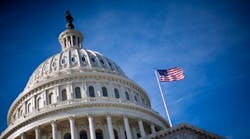The federal government appears to be taking energy efficiency and infrastructure investment seriously with moves over the past week to focus on energy matters.
First, the House and Senate approved legislation to reduce regulatory burdens and increase transparency on energy efficiency efforts for federal properties. The Energy Efficiency Improvement Act of 2015, which The National Electrical Manufacturers Association (NEMA) called “a no-cost, no-mandate bill that helps advance energy efficiency through reduced regulatory burden, increased transparency, and a focus on the federal government as a first mover to save taxpayer dollars on energy bills,” is now on its way to President Obama for signature.
Once signed into law the bill will establish “Tenant Star,” a voluntary approach to aligning the interests of commercial building owners and their tenants to reduce energy consumption, it will exempt certain electric resistance water heaters used for utility demand response programs from pending Department of Energy regulation, and require that federally-leased buildings benchmark and disclose their energy usage data.
The White House also released its first Quadrennial Energy Review (QER), which is intended to be a regular review of energy issues to provide a multi-year policy roadmap. Based on the QER, administration officials including Vice President Joe Biden and Energy Secretary Ernest Moniz hit the road to call on Congress for billions of dollars in new spending to repair natural gas pipelines, upgrade the electric grid and overhaul the nation’s energy transport and storage infrastructure.
NEMA released a statement commending the administration for releasing QER, and its focus on improving the nation’s energy infrastructure. “The administration’s analysis of infrastructure needs for transmission, storage, and distribution is especially timely as the House Energy and Commerce Committee and the Senate Energy and Natural Resources Committee undertake a crucial review of national energy infrastructure and development of broad based energy legislation,” NEMA said.
The statement included NEMA’s recommendation for strategic siting of spare transformers to enable rapid response to electrical outages.
NEMA added its next priorities for consideration as Congress and the administration move forward with energy legislation, including five-year accelerated depreciation to incentivize investment in smart grid technologies; incentivizing the construction of microgrids; allowing federal disaster aid to be used for smart rebuilding; and permitting federal regulators to facilitate new interstate transmission lines with “backstop” authority to act when states are at an impasse.









